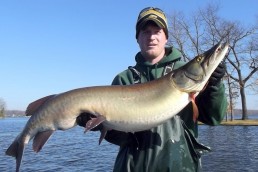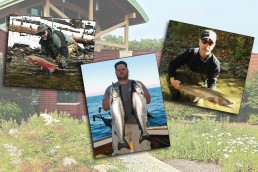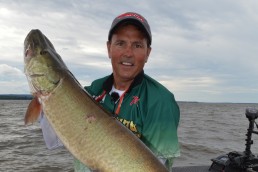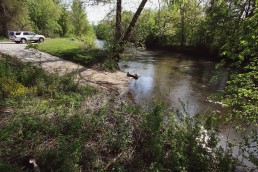Fishing Indiana Muskies
SHARE THIS POST
Indiana muskies get no respect
Indiana may just be the hidden muskie capital of the Midwest. With muskies biting, by some reports, twice as frequently as in other states and with superb specimens netted by DNR biologists, muskie anglers might want to point the prow to Indiana waters.
Are Indiana’s muskie lakes starting to get the respect they deserve?
Maybe. But not as much as muskie biologist Jed Pearson believes they should.
Webster Lake has long been known as the crown jewel of Indiana muskie fishing. It’s been recognized regionally, and to some extent, nationally. It and nearby Barbee Chain and Lake Tippecanoe get most of the attention. All of those lakes are in Kosciusko County.
“We think it’s important to get more information out there about the quality of fishing we have here,” said Pearson. “We’re seeing it in our surveys. Now it’s a matter of getting anglers to try other waters and see what they are missing.”
Three well-known lakes…
The Webster/Barbee/Tippecanoe trio of muskie lakes are fairly well known and garnering more attention.
The Indiana Classic has been held there for several years, attracting avid muskie anglers from around the region.
Even more recognition is coming. The Professional Musky Tournament Trail announced recently that it will host the Ranger Boats World Championship at the Barbee Chain, Lake Tippecanoe and Lake Webster on Oct. 21.
…less-pressured lakes with big muskies
But Pearson says those aren’t the only lakes that deserve angler attention. Other northern Indiana muskie lakes are Everett in Allen County, Loon in Whitley County, Skinner in Noble County and Bruce in Fulton County. In southern Indiana, Brookville Reservoir northwest of Cincinnati and Bass Lake near Sullivan are a couple.
Pearson’s northern Indiana team keeps tabs on his lakes. They’re stepping up efforts to gather even more population data to prove to anglers they are overlooking other muskie fisheries.
Long thought to be elusive, muskies bite on a variety of lures, many of which bass anglers use. Casting large plugs or trolling spoons along submerged weed beds are the most productive methods.
“Muskies are known as the fish of 10,000 casts,” he said. “We want people to know we have something better than that.”
Are you enjoying this post?
You can be among the first to get the latest info on where to go, what to use and how to use it!
Above-average waters
Based on data received from muskie fishing guides, a few of Indiana’s muskie waters are performing well above average.
“Some states determine that angler reports of one fish per 30 angler hours of fishing makes a good muskie fishery,” he explained, “but our data show that our anglers are getting one per 14 hours on the water. Our guides report they are putting more fish in the boat than what occurs in most states. Sure, some of our fish are small but it’s a good sign that our muskie fishing is there and improving.”
Most of the monitored guide trips are on Webster, Tippy and Barbee, but Pearson said his lake studies show other lakes have a lot of big fish.
“Lakes like Skinner and Bruce are loaded with muskies but not getting the fishing pressure,” Pearson said, pointing out that he’s documented 50-inch fish in Bruce. “We’re trying to get fishermen who know how to catch them to fish those lakes and tell us how they match up. But our netting projects show they are there.”
Big brute muskies
The muskie minimum size limit is 36 inches, but muskies caught at Lake Webster and the adjacent Backwater Area must be a at least 44 inches to be kept.
Of course, most muskie anglers release the fish they catch anyway.
Webster, in particular, is experiencing a turnaround after going through a period when it only produced big fish and not many small ones. The rate of survival of stocked fish diminished. There is little, if any, natural muskie reproduction in Indiana waters so the success of the fisheries is hatchery dependent.
However, changes made two years ago are producing better results. In 2016, biologists changed the diet of hatchery raised fish and are stocking them at a bigger size.
“Guides tell us that they saw a lot of improvement at Webster last year and we think it’s the result of those changes,” Pearson said.
If the upward trend continues, this should be another good year for muskie fishing with even better to come in subsequent years.
Author Notes:
Louie Stout is a Hall of Fame journalist and longtime “Bassmaster” Senior Writer who has covered Indiana and Michigan outdoors for more than 40 years. He’s co-authored three books with Kevin VanDam and is the outdoors columnist for the South Bend Tribune.
MWO
SHARE THIS POST
Did you enjoy this post?
You can be among the first to get the latest info on where to go, what to use and how to use it!
Louie Stout
Louie Stout is a Hall of Fame journalist and longtime Bassmaster Senior Writer who has covered Indiana and Michigan outdoors for more than 40 years. He’s co-authored three books with Kevin VanDam and is the outdoors columnist for the South Bend Tribune.



